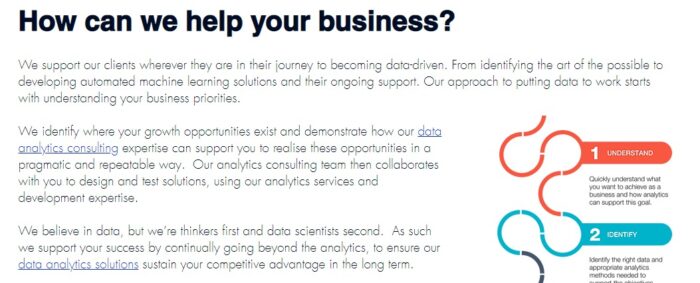User experience (UX) is not just the domain of the design team. Creative marketers need to understand it too. Don't worry, reading this article will help! In fact, the success of your work may depend on it...
Our new series of blog posts is inspired by the University of Glasgow Online MSc Marketing programme. Today we examine why marketers need to understand the impact of UX.
The term user experience (UX) was coined in 1993 by the cognitive psychologist and designer Don Norman. Its purpose was to encapsulate the complex challenges of providing customer service in the digital era. But the basic concept behind UX is not exactly new.
In fact, its principles can be traced all the way back to 4000 BC and the Chinese Philosophy of Feng Shui. While marketers may – or may not – benefit from rearranging their office furniture, they almost certainly will benefit from understanding the principles of UX and how it relates to the products and services they are responsible for selling.
In this article, I’ll explain in more detail how UX assists with marketing efforts (accompanied by a few practical examples) and look at how marketers can gain a better grasp of UX.
UX design is just one of the optional courses included in the University of Glasgow Online MSc Marketing programme. Delivered by the triple-accredited Adam Smith Business School, it gives students the tools to succeed now and into the future. Discover how the programme can expand your digital marketing expertise.
What is user experience (UX)?
 Let’s start with a definition of UX. Here’s a pretty good one courtesy of ProductPlan:
Let’s start with a definition of UX. Here’s a pretty good one courtesy of ProductPlan:
“User Experience refers to the feeling users experience when using a product, application, system, or service. It is a broad term that can cover anything from how well the user can navigate the product, how easy it is to use, how relevant the content displayed is etc.”
So, it’s not just about the actual product you are selling but also the customer’s experience when using your website and seeking customer assistance.
Let’s consider it from a bricks and mortar retail perspective. You wake up one morning, open your wardrobe and decide: I need to freshen up my home office attire. It’s time to visit a fashion retailer…
First you visit the store. But why did you choose to go there? And how did you discover it?
Once in the shop, did you find what you need? Did the product suit your needs? How quickly were you served at the checkout? How good was the service?
Post-purchase, did the product live up to expectations? Were you happy with it? Will you return to the store and buy something in the future? Is there an incentive to return?
These same questions apply to your digital experiences and, when applicable, how it connects with the physical experience.
How knowledge of UX improves marketing
 Marketing teams are busy bodies (or at least, brains!) with a variety of important duties including:
Marketing teams are busy bodies (or at least, brains!) with a variety of important duties including:
• Pulling people to the website via advertising, networking, public relations and content marketing (including SEO).
• Converting prospective customers into paying customers via persuasive copy amidst great page design.
But all the time, energy and expertise that you pour into marketing will count for nothing if the website doesn’t work properly or the product you’re selling doesn’t meet or exceed the customer’s expectations.
Marketing spend is not a charitable donation. Purse string holders want tangible results, they want marketing to equal sales. Problem is, if UX fails so will your marketing.
And marketing doesn’t end with the sale. If the product fails to deliver, the customer will not become a repeat customer nor recommend the product to their peers. However, get the product design right, and the reverse is true.
Great product design is a great marketing tool in its own right. This is why marketing should always have a place at the boardroom. Here, your can offer your own perspective and potentially influence key decisions which may impact the success or otherwise of your marketing.
The best marketers are proactive. They understand that their role doesn’t exist in a silo. Marketing is connected to almost every other part of the business. And UX underpins everything.
Marketers need to truly understand the user experience – whether it’s in relation to the customer journey across the sales funnel or their experience of using the product. That’s the only way that you can create powerful marketing campaigns and achieve great results for the business.
To create the most effective marketing, you need to ‘get’ the product.
Future-proof your business by mastering UX alongside other cutting edge marketing disciplines and technologies. Discover the University of Glasgow Online MSc Marketing programme.
Hack marketing vs quality marketing
It’s worth looking at a couple of examples. Here I’m simply focusing on copy. But it’s important to reiterate: design also plays an essential role.
First up, a piece of ‘hack’ marketing from a business homepage. It’s full of buzzwords and cliches which suggest whoever wrote it failed to get under the bonnet of how the business benefits customers (note: names and locations have been withdrawn!):
As one of the leading title companies in the nation, COMPANY is your best choice as a title insurance partner because we understand your business. Through our network of offices and agents, we provide title services for every county in LOCATION. COMPANY offers you the convenience and efficiency of our centralized services, providing one-stop shopping to meet your real estate closing needs, whether you are an attorney, builder, lender, real estate professional, or consumer. Our world-class technology services allow you to order title online, produce high-quality documents, and receive products electronically.
It goes on and on in big chunky paragraphs stitched together with all the tired old labels people have glazed over countless times before. Did the writer have the chance to talk to real customers and truly understand the benefits from the customer’s perspective?
It’s the customer-eye view which can transform the copy from generic ‘here’s what we do’ terminology, to ‘here’s how you can benefit’ in a specific and tangible way. It’s a shame because the overall layout of the site is perfectly fine.
Contrast that with this effort from data science company Beyond Analysis (nice brand name incidentally). They’ve really seen it from a customer’s point of view, the marketing team clearly gets it and have understood the business and its UX.
This copy abides by the classic marketing rule: emphasise how your product benefits the customer rather than list what your business does. And this is just one element of why understanding UX matters. It influences more than the wording, it influences the design and flow of the site too.
It’s time to join the UX conversation
 In practical terms, how do you better understand UX? It requires you to build relationships across the business, including with:
In practical terms, how do you better understand UX? It requires you to build relationships across the business, including with:
• Product and web design teams
• Business decision makers
• Sales and customer service teams
But also, you also need to understand the customer perspective via:
• One-to-one conversations
• Customer surveys and product reviews
• Social media conversations (by reading opinions and/or joining the conversation)
• Analysing key website metrics and product usage insights
To build a truly informed marketing strategy, you need to ensure that UX is understood from every relevant perspective. For smaller businesses with limited marketing budgets, marketers will have to prioritise the most important elements of UX. You may even need to educate business leaders and budget controllers about how your marketing efforts will benefit from a better understanding of UX across the business.
In an age of digital disruption, UX is ever evolving – offering challenges and opportunities for all marketing teams. If marketers can stay in the loop about UX – and indeed, contribute to conversations surrounding it – they can continue to serve customers with all the right messaging in all the right places.
Would you like to upgrade your marketing expertise and earning potential? UX is taught alongside a full range of new and traditional marketing disciplines at the University of Glasgow Online MSc Marketing programme.
Delivered by the triple-accredited Adam Smith Business School, it explores the latest topics from analytics to user experience, along with core marketing essentials. Find out how you can unlock new opportunities in your marketing career.
Image by mohamed Hassan from Pixabay









Leave your thoughts